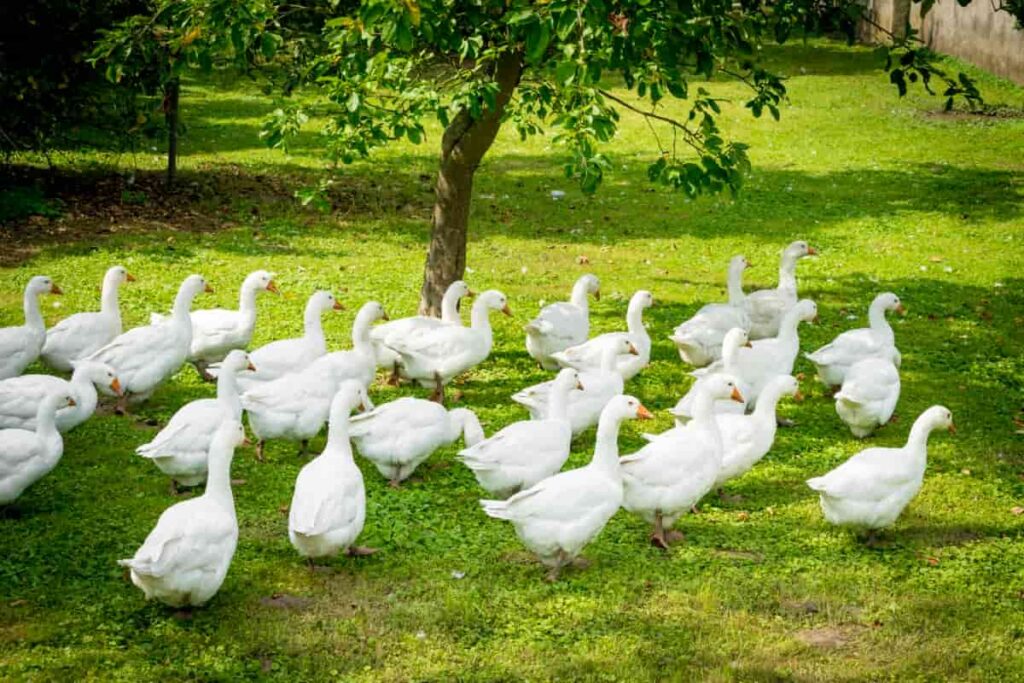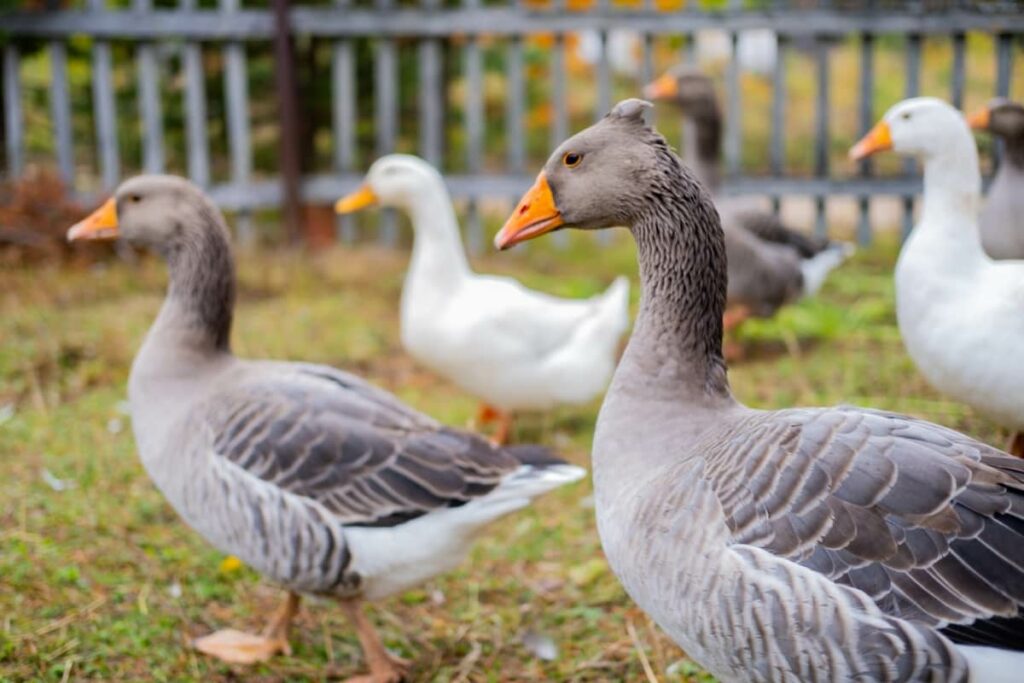Raising geese in your backyard comes with numerous advantages. These birds excel at foraging, making them natural allies in managing pests such as slugs, snails, and various insects, thereby minimizing the reliance on chemical pesticides. Their natural grazing habits contribute to the maintenance of your lawn, keeping it neatly trimmed in an environmentally friendly manner.

Certain breeds of geese also produce a significant number of eggs and offer a sustainable meat source, enhancing your self-reliance. Additionally, geese are alert and vocal, acting as efficient guardians by notifying you of any suspicious presence or activities near your home.
Raising Geese in Backyard
Choosing the Right Breed for Your Needs
When choosing a breed for a backyard flock, consider factors such as temperament, egg-laying capabilities, meat production, and climate adaptability. Best geese breeds for backyards include Toulouse, Embden, Sebastopol, and African Geese, each offering unique characteristics suited to various preferences and environments.
Setting Up Your Goose Habitat
Essential Shelter Requirements
Building a goose coop includes constructing a sturdy shelter that protects from harsh weather conditions, predators, and disturbances. Ensure adequate ventilation to prevent respiratory issues, and use bedding material such as straw or hay for insulation and comfort. Regularly clean the shelter to maintain cleanliness and hygiene. Additionally, consider providing nesting boxes for egg-laying geese to encourage natural behaviors.
Fencing and Security Against Predators
Use sturdy materials (wire mesh or electric fencing) to create a barrier around the enclosure. Inspect fences regularly for signs of damage and promptly repair any weak spots. Consider installing predator-proof netting over the top of the enclosure to prevent aerial attacks from birds of prey. Additionally, implementing deterrents such as motion-activated lights or sound devices to protect geese from predators.
Feeding Your Geese
Understanding Nutritional Needs
Geese require a balanced diet to maintain optimal health and productivity. Their diet should consist of a combination of grains, greens, and protein sources. Offer a commercial waterfowl feed or a mixture of grains like wheat, corn, and barley. Supplement their diet with leafy greens, vegetables, and occasional treats like fruits. Always provide access to fresh and clean water at all times, especially during feeding.
Best Practices for Feeding and Watering
Feed your geese twice daily, providing enough food to satisfy their hunger without overfeeding. Scatter food on the ground or use feeding troughs to prevent competition and ensure all geese have access to feed. Clean and refill water containers daily, as geese require ample water for digestion and hydration.
Health and Wellness
Common Goose Health Issues and Prevention
Geese are susceptible to various health issues, including respiratory infections, parasites, and injuries. As health tips for backyard geese, preventive measures such as regular cleaning of living quarters, providing clean water, and maintaining a nutritious diet can help boost their immune system and minimize the risk of illness. Monitor your geese for signs of illness, such as lethargy, decreased appetite, or abnormal behavior, and consult a veterinarian if necessary.
Routine Care and Veterinary Visits
Schedule annual veterinary check-ups to assess overall health, update vaccinations, and address any concerns. Establishing good hygiene practices, proper nutrition, and routine veterinary care can contribute to the longevity and vitality of your backyard goose flock.
In case you missed it: Everything about Cayuga Duck: Breeding, Raising, and Care for Eggs and Meat

Breeding Geese
The Basics of Goose Breeding
Breeding geese involves selecting compatible pairs, providing appropriate nesting sites, and facilitating natural mating behaviors. Ensure your breeding geese are mature and in good health before attempting to breed them. Provide nesting materials such as hay or straw in secluded areas to encourage egg-laying behavior. Monitor breeding pairs for successful mating, which typically occurs in the spring months.
Incubation and Hatching Tips
If opting for artificial incubation, maintain proper temperature and humidity levels throughout the incubation period. Turn eggs regularly to prevent the embryo from sticking to the shell and ensure uniform development. Monitor eggs closely for signs of fertility and discard any infertile or damaged eggs. Prepare a suitable brooder area for newly hatched goslings, providing warmth, food, and water to support their growth and development.
Raising Goslings
Care for Young Goslings
Provide a clean and warm brooder environment with a bedding material like wood shavings or straw. Maintain a consistent temperature of around 33-35°C for the first week, gradually reducing it as the goslings grow feathers. Offer a balanced diet of commercial waterfowl starter feed and fresh water, ensuring easy access for raising goslings in your garden.
Integrating Goslings with Adult Geese
Begin by allowing supervised interactions between goslings and adult geese in a controlled environment. Monitor for signs of aggression or territorial behavior from adult geese and intervene if necessary to prevent injury to the goslings. Provide separate feeding and resting areas initially to minimize competition and allow goslings to establish their place within the flock. With patience and proper supervision, goslings can successfully integrate geese with other backyard poultry.
Behavior and Training
Understanding Goose Behavior
Geese are highly social animals, forming strong bonds with their flock mates and demonstrating hierarchical structures within the group. They communicate through vocalizations, body language, and various behaviors such as honking, flapping wings, and head bobbing.
Tips for Handling and Training
Begin by spending time with your geese daily, offering treats and gentle interactions to build a bond. Use rewards such as favorite foods or praise to encourage desired behaviors such as coming when called or following commands. Be patient and consistent in the training approach, and avoid using force or punishment, as this can lead to fear or aggression.
Seasonal Care for Backyard Geese
Winter Preparations for Your Geese
Ensure your geese have adequate shelter from harsh weather conditions, with insulated housing and ample bedding material to provide warmth. Provide access to fresh, unfrozen water at all times, using heated water or breaking ice regularly to prevent dehydration. Increase their calorie intake during colder months by offering supplemental organic feed for geese or higher-fat foods to help maintain body condition and energy levels.
Managing Heat Stress in Summer
Provide shade and sheltered areas for your geese to escape the sun’s direct rays, such as trees, awnings, or purpose-built shelters with good ventilation. Ensure access to cool, clean water at all times, and consider adding electrolytes to their drinking water to help prevent dehydration. Limit strenuous activities during the hottest times of the day and provide shallow pools or misting systems for geese to cool off.
Goose Egg Harvesting and Utilizing Goose Products
Eggs, Meat, and Down: Benefits and Uses
Geese provide various valuable products, including eggs, meat, and down feathers. Goose eggs are nutritious and can be used in cooking and baking, offering a rich flavor and texture. Goose meat is prized for its tenderness and distinct taste, making it a popular choice for culinary dishes. Down feathers from geese are highly insulating and are used to fill pillows, comforters, and clothing, providing warmth and comfort.
Ethical Considerations and Practices
Ensure that geese are raised in a comfortable and natural environment, with access to adequate food, water, and shelter. Utilize humane slaughter methods that minimize stress and pain for the geese. Respect the natural behaviors and instincts of geese throughout the harvesting process and prioritize their welfare above all else. Transparent communication with consumers about your ethical practices can also help build trust and support for your products.
In case you missed it: Pomeranian Duck Profile: Origin, Characteristics, Size, Eggs, Lifespan, Uses, and Price

Common Challenges and Solutions
Dealing with Aggression and Noise
Provide ample space and feeders to minimize competition among geese. Implementing a strict hierarchy within the flock can also help reduce aggression. For noise management, consider locating geese away from residential areas or utilizing sound-dampening barriers. Training geese to respond to commands can also help control excessive vocalization.
Overcoming Feeding and Health Issues
Feeding backyard geese and health issues can arise due to improper diet, environmental stressors, or disease. Ensure that geese receive a balanced diet rich in nutrients, supplemented with vitamins and minerals as needed. Maintain clean living quarters and provide access to fresh water to prevent health issues such as respiratory infections or parasites. Monitor geese regularly for signs of illness or distress and consult a veterinarian for proper diagnosis and treatment.
In case you missed it: Duck Farming Basics, Housing, Feeding for Eggs, Meat

Conclusion
Raising geese in your backyard offers a multitude of benefits, including pest control, lawn maintenance, and a sustainable source of eggs, meat, and down feathers. By using this Backyard geese breeding guide, understanding their nutritional needs, providing proper shelter, and implementing ethical practices, you can create a thriving environment for your Geese as backyard pets.
- Crops Grown in Summer Season: Best Choices for Summer Gardening
- Organic Pest Control for Tomato Farming
- How to Maximize Sheep Farming Profit
- Broccoli Varieties: Choosing the Right Cultivars for Your Farm
- How to Raise Pigs in Your Own Backyard: A Comprehensive Guide
- Budget Friendly Sheep Shed Ideas: Cheap and Low-Cost Tips
- How Much Do Cattle Farmers Make: Revenue Streams in Cattle Farming
- Management Pests and Diseases in Your Cotton Field
- Sheep Farming Business Plan for Beginners
